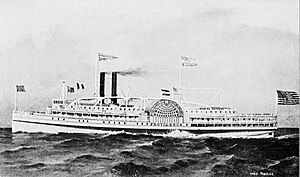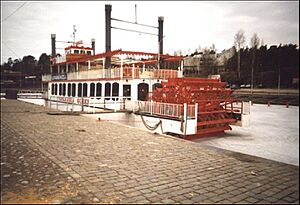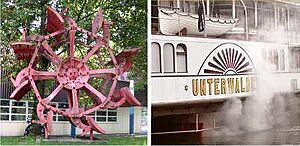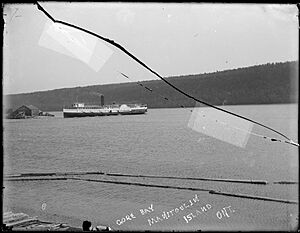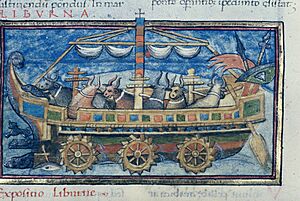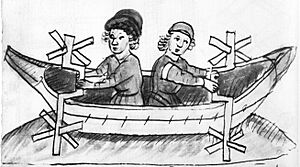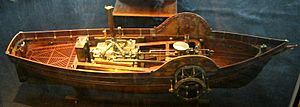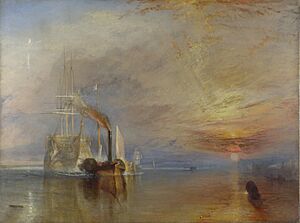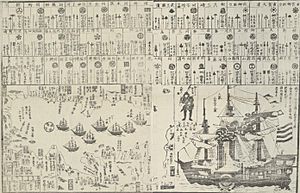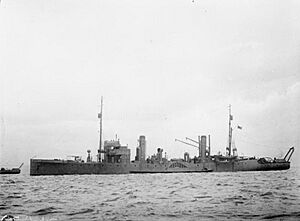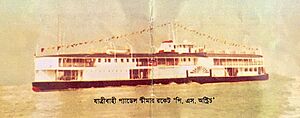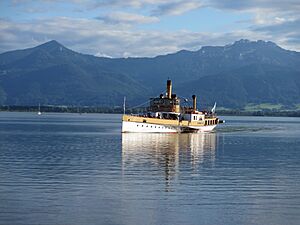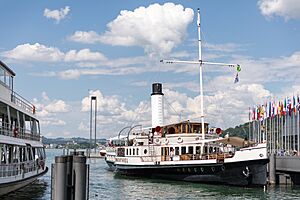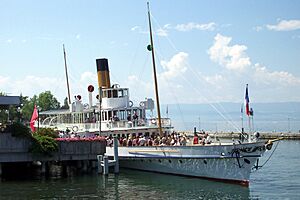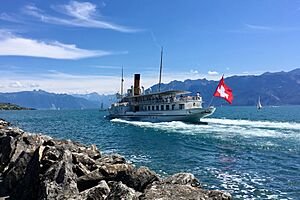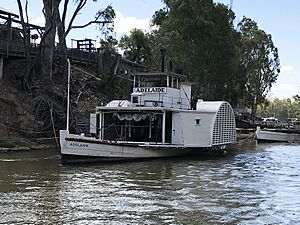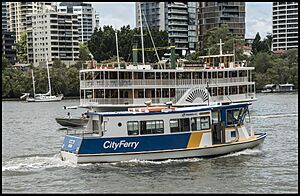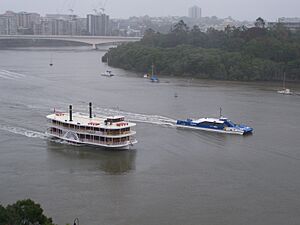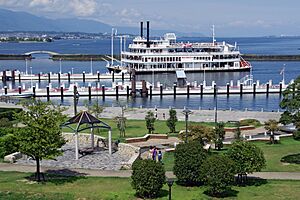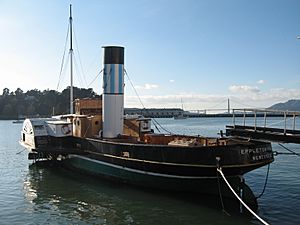Paddle steamer facts for kids
A paddle steamer is a type of boat that uses a steam engine to turn large wheels with paddles. These paddles push against the water to make the boat move. Long ago, people used paddle wheels powered by animals or humans before steam engines existed.
In the early 1800s, paddle wheels were the main way to power steam boats. But by the late 1800s, the screw propeller became more common. Propellers work better, especially in rough or open water. Today, you can still see paddle wheels on small pedal boats and on some ships used for tourist trips. These tourist boats often use diesel engines instead of steam.
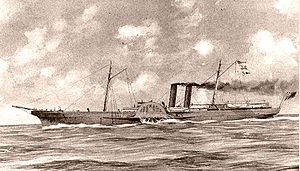
Contents
Paddle Wheels
A paddle wheel is a big metal wheel with many paddle blades, called floats or buckets, around its edge. About a quarter of the wheel goes under the water. The engine spins the paddle wheel in the water to create thrust, which pushes the boat forward or backward.
Some paddle wheels have special "feathering" designs. This design keeps each paddle blade almost straight up and down while it's in the water. This makes the boat move more efficiently. The top part of a paddle wheel is usually covered by a paddlebox. This helps stop water from splashing everywhere.
Types of Paddle Steamers
There are three main types of paddle steamers:
- Stern-wheelers: These have one large paddle wheel at the back of the boat.
- Side-wheelers: These have one paddle wheel on each side of the boat.
- Inboard paddlewheelers: These have the paddle wheel hidden inside a special space in the middle of the boat.
All these types were used as riverboats in the United States. Some still operate today for tourists, especially on the Mississippi River.
Stern-wheelers
Even though the first stern-wheelers were invented in Europe, they were most popular in North America. They were especially common on the Mississippi River. The Enterprise was built in Pennsylvania in 1814. It was an improvement over the less efficient side-wheelers.
The second stern-wheeler, Washington (built in 1816), had two decks. It became the model for all later steamboats of the Mississippi. These boats were made famous in Mark Twain's book Life on the Mississippi.
Side-wheelers
Side-wheelers are used as riverboats and also for travel along coasts. Their side wheels and covers (called sponsons) make them wider than stern-wheelers. However, they can be easier to steer. This is because they can sometimes move their paddles at different speeds, or even in opposite directions.
This extra steering ability made side-wheelers popular on the narrower, winding rivers of the Murray–Darling system in Australia. Many still operate there today.
European side-wheelers, like PS Waverley, often connect their wheels with solid drive shafts. This limits how much they can turn independently. Some were built with special clutches to let paddles move separately. But early experience showed that if passengers moved to one side of the ship, it could become unbalanced and even tip over. So, most side-wheelers were operated with the paddles connected.
Inboard Paddlewheelers
Inboard paddlewheel boats were designed for narrow rivers with many hidden obstacles. By placing the wheel inside the boat's hull, it was better protected from damage. This design also allowed the wheel to spin very fast, making the boat easy to steer in tight spaces.
Feathering Paddle Wheel
In a simple paddle wheel, the paddles are fixed in place. This means some power is wasted as the paddles enter and leave the water. Ideally, the paddles should stay straight up and down while they are in the water.
This can be done with a "feathering" paddle wheel. It uses levers and rods connected to a special off-center point. This design makes sure the paddles stay almost vertical for the short time they are pushing through the water. This makes the boat more efficient.
History
Early Paddle Wheels
The idea of using a paddle wheel for boats first appeared in ancient Roman writings. The Roman engineer Vitruvius described paddle wheels working like a ship's odometer (a device to measure distance). The first mention of paddle wheels for moving a boat came from a Roman military book in the 4th or 5th century. It described a warship powered by oxen turning paddle wheels.
Later, in the 14th century, an Italian physician named Guido da Vigevano drew plans for a paddle boat powered by hand cranks. In the 15th century, drawings showed boats with paddle wheels turned by men using cranks.
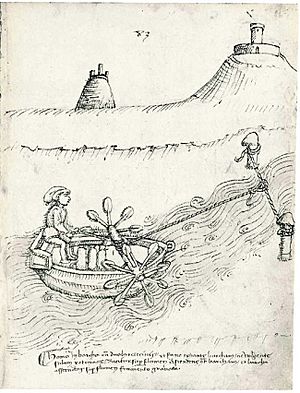
In the 16th century, Spanish engineer Blasco de Garay built ships with hand-powered side paddle wheels. One of his ships, La Trinidad, was said to be faster than a nearby galley. However, the project was stopped.
In 1705, Papin built a ship with hand-cranked paddles. Some stories mistakenly claimed this ship was steam-powered, but this was later proven wrong.
The First Steam Paddle Boats
One of the first working steamships was Palmipède, built in France in 1774 by Marquis Claude de Jouffroy. This 13-meter (43-foot) steamer with rotating paddles sailed on the Doubs River in 1776. In 1783, de Jouffroy's new paddle steamer, Pyroscaphe, successfully steamed up the river Saône for 15 minutes before its engine broke down.
The next successful attempt was by Scottish engineer William Symington. In 1802, Symington built Charlotte Dundas, a barge-hauler. It successfully pulled two 70-ton barges almost 20 miles (32 km) in 6 hours against a strong wind. This was the first commercial paddle steamer. However, the canal company worried about damage to the canal banks, so no more were ordered.
The first commercially successful paddle steamer was Robert Fulton's Clermont in New York. It started regular service in 1807 between New York City and Albany. Many other paddle riverboats followed around the world. The first in Europe was PS Comet, which began passenger service on the River Clyde in 1812.
In 1812, the first U.S. Mississippi River paddle steamer began operating from New Orleans. By 1814, Captain Henry Shreve had created a "steamboat" perfect for the local rivers. The number of landings in New Orleans grew from 21 in 1814 to over 1,200 in 1833.
The largest paddle steamer on the Mississippi was the sternwheeler Sprague. Built in 1901, it pushed coal and oil until 1948.
In Europe, from the 1820s, paddle steamers took tourists from busy cities on river cruises or to new seaside resorts. These resorts built pleasure piers for passengers to get off the boats easily. Later, these steamers had fancy rooms to compete with trains. Famous examples include the Thames steamers in London and the Clyde steamers in Glasgow. Paddle steamer services continued until the mid-20th century, when cars made them less necessary. Only a few historic examples remain.
Paddle Steamers in Asia
China
The first mention of a paddle-wheel ship in China is from the 7th century. It describes naval ships used in 418 AD. The ancient Chinese mathematician Zu Chongzhi (429–500) built a paddle-wheel ship called the "thousand league boat".
Later, in 552, Admiral Xu Shipu used paddle-wheel boats called "water-wheel boats." In 784 AD, Prince Li Gao designed a successful paddle-wheel warship. The Chinese Song dynasty (960–1279) built many paddle-wheel ships for its navy. According to historian Joseph Needham, "between 1132 and 1183 (AD) a great number of treadmill-operated paddle-wheel craft, large and small, were built, including sternwheelers and ships with as many as 11 paddle-wheels a side."
The Song government used paddle-wheel ships to defeat pirates and in battles against the Jin dynasty in 1161. The Chinese continued to use paddle-wheel ships even during the First Opium War (1839–1842) and for transport on the Pearl River in the early 1900s.
Bangladesh
Paddle steamers in Bangladesh began operating in 1878. Many steamers, like the Garrow and Florikan, were important on the southern rivers. In 1958, Pakistan River Steamers took over the fleet.
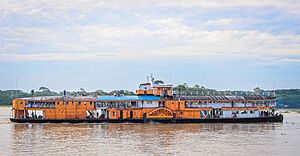
After Bangladesh became independent in 1972, about 13 paddle steamers, nicknamed “the Rockets” for their speed, were operated by the Bangladesh Inland Water Transport Corporation (BIWTC). These included PS Sandra, PS Mahsud, and PS Tern. They served cities like Chandpur, Barisal, and Khulna from Dhaka.
In the 1980s, their steam engines were replaced with diesel ones. Wooden paddles were replaced with iron. Modern equipment like radar and GPS was also added. However, some steamers were decommissioned after catching fire.
Until 2022, four paddle steamers—PS Ostrich (built 1929), PS Mahsud (1928), PS Lepcha (1938), and PS Tern (1950)—were operated by the BIWTC once a week. Commercial services eventually stopped due to safety worries, financial losses, and fewer passengers, especially after the Padma Bridge opened.
Seagoing Paddle Steamers
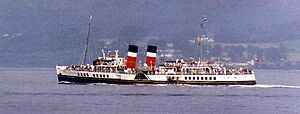
The first paddle steamer to travel on the open sea was the Albany in 1808. It went from the Hudson River along the coast to the Delaware River. This was just to move the boat to a new area. But soon, paddle steamers began regular short coastal trips.
In 1819, SS Savannah was built specifically to cross the Atlantic Ocean. It set out for Liverpool on May 22, 1819, and saw Ireland after 23 days. This was the first powered crossing of the Atlantic. However, Savannah was also a sailing ship and couldn't complete the trip on steam alone.
In 1838, Sirius became the first ship to cross the Atlantic using only steam power for the whole journey. It beat Isambard Kingdom Brunel's larger Great Western by a day. Great Western was built for transatlantic travel and had enough coal. Sirius ran out of coal and had to burn furniture! Great Western's successful crossing started regular steamship travel across the Atlantic.
Paddle steamers like the Black Ships helped open Japan to the Western World in the mid-1800s.
The largest paddle steamer ever built was Brunel's Great Eastern. It was 692 feet (211 meters) long and weighed 32,000 tons. Its paddlewheels were 56 feet (17 meters) across.
Paddle steamers became less useful for ocean travel after the screw propeller was invented. But they were still used for coastal trips and as river tugboats. This was because they could operate in shallow water and were easy to steer.
The last Atlantic crossing by a paddle steamer began in 1969. The steam paddle tug Eppleton Hall traveled from Newcastle to San Francisco. It was not meant for ocean travel, but it made the journey. This trip happened exactly 150 years after the Savannah's voyage.
As of 2022, the PS Waverley is the last seagoing passenger-carrying paddle steamer in the world.
Paddle-Driven Steam Warships
Paddle Frigates

Starting in the 1820s, the British Royal Navy began building paddle-driven steam frigates and steam sloops. By 1850, these ships were outdated because of the propeller. Propellers were more efficient and less likely to be damaged by cannon fire. One of the first screw-driven warships, HMS Rattler (1843), showed it was better than paddle steamers in trials. In one trial in 1845, it pulled a paddle-driven sister ship backward in a tug of war.
However, paddle warships were used a lot by the Russian Navy during the Crimean War (1853–1856). They were also used by the United States Navy during the Mexican–American War (1846–1848) and the American Civil War (1861–1865). When ironclad battleships appeared in the late 1850s, the last paddle frigates were sold to merchant-navy service by the 1870s.
Paddle Minesweepers
At the start of First World War, the Royal Navy took over more than fifty pleasure paddle steamers. They used them as auxiliary minesweepers. The large open decks, meant for passengers, were perfect for handling minesweeping equipment. The paddles allowed them to work in shallow coastal waters and rivers. These ships were so successful that a new class of paddle ships, the Racecourse-class minesweepers, was ordered. 32 of them were built before the war ended.
In the Second World War, about thirty pleasure paddle steamers were used again. An extra benefit was that their wooden hulls did not trigger the new magnetic mines. These paddle ships formed six minesweeping groups along the British coast. Other paddle steamers were turned into anti-aircraft ships.
More than twenty paddle steamers were used to transport troops during the Dunkirk Evacuation in 1940. They could get very close to the shore to pick up soldiers directly from the beach. For example, PS Medway Queen saved an estimated 7,000 men during the nine days of the evacuation. It also claimed to have shot down three German planes. Another paddle minesweeper, HMS Oriole, was deliberately beached twice. This allowed soldiers to cross to other vessels using it as a bridge. Paddle steamers rescued an estimated 26,000 Allied troops during the operation, though six of them were lost.
Modern Paddle Steamers
US and Canada
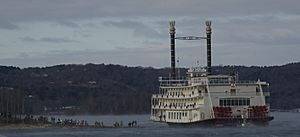
A few paddle steamers are still used for tourism on lakes and rivers. For example, Delta Queen still operates on the Mississippi River. In Oregon, several replica paddle steamers, which are not steam-powered, are used for tourism on the Columbia and Willamette Rivers.
USS Wolverine, built in 1912 as PS Seeandbee, was the biggest passenger-carrying paddle steamer ever built. It could hold 6,000 passengers. It was later changed into a training aircraft carrier during World War II.
Belle of Louisville is the oldest operating Mississippi River-style steamboat. It was named a National Historic Landmark in 1989. It is based in downtown Louisville, Kentucky.
The Shelburne Museum in Vermont has the paddle steamer Ticonderoga. This preserved Lake Champlain ferry was moved overland to the museum after it stopped service in 1953. You can now tour it.
The San Francisco Maritime National Historical Park has the Eureka. It is the largest existing wooden ship in the world and is still floating as a museum ship.
The ferries system in Toronto, Ontario, Canada, operates PS Trillium. This paddle steamer was built in 1910 and restored in 1976. It is the last sidewheel-propelled vessel on the Great Lakes.
Germany
The Elbe river Saxon Paddle Steamer Fleet in Dresden, Germany, is the oldest and biggest in the world. The 1913-built Goethe was the last paddle steamer on the River Rhine. It was once the world's largest sidewheeler. Goethe was converted to diesel power in 2008/09.
Paddle wheelers still operate on some lakes in Southern Bavaria. For example, Diessen on Ammersee was built in 1908 and converted to diesel in 1975. A new paddle wheeler, Herrsching, was even built in 2002 on Ammersee, but it has never been steam-powered. On Lake Chiemsee, RMS Ludwig Fessler (built 1926) is still in regular service, but it also uses diesel engines since 1973.
Bangladesh
The four paddle steamers owned by the Bangladesh Inland Water Transport Corporation stopped commercial operation in 2022. As of 2024, the agency is renovating PS Ostrich (1929), which has been leased to a private tour company. PS Lepcha (1938) and PS Tern (1950) are also being offered for lease. PS Mahsud (1928) is being kept by the government for tours.
Austria
Austria has a small paddle steamer fleet. This includes Gisela from 1872 on the Traunsee, Kaiser Franz Josef I. from 1873 on Lake Wolfgang, Hohentwiel from 1913 on Lake Constance, and Schönbrunn from 1912 on the Danube.
Italy
In Italy, a small paddle steamer fleet operates on Lake Como, Lake Maggiore, and Lake Garda for tourists. The paddle steamer Piemonte (1904) is on Lake Maggiore. Sister paddle steamers Patria (1926) and Concordia (1926) are on Lake Como. Former paddle steamers Italia (1909) and Giuseppe Zanardelli (1903) on Lake Garda had their steam engines replaced with diesel ones in the 1970s.
Denmark
SS Hjejlen has been operating with the same company since it was built in 1861. It still carries passengers to and from Silkeborg and Himmelbjerget, using its original steam engine.
Norway
Skibladner is the oldest steamship in regular operation. Built in 1856, it still operates on Lake Mjøsa in Norway.
Switzerland
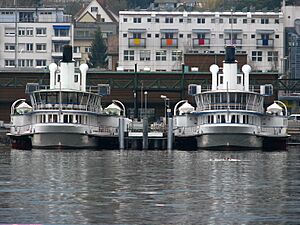
Switzerland has a large paddle steamer fleet. Many were built by Sulzer or Escher Wyss. There are five active and one inactive on Lake Lucerne, two on Lake Zurich, and one each on Lake Brienz, Lake Thun, and Lake Constance. Swiss company CGN operates several paddle steamers on Lake Geneva. Their fleet includes some converted to diesel electric power and five that still use steam. One, Montreux, was converted back to a new steam engine in 2000. It is the world's first electronically remote-controlled steam engine.
Active Vessels
- Lake Biel, Morat, and Neuchâtel: Neuchâtel (built 1912)
- Lake Brienz: Lötschberg (1914)
- Lake Geneva: Montreux (1904), Italie (1908), La Suisse II (1910), Savoie (1914), Simplon (1919), Rhône III (1927)
- Lake Lucerne: Stadt Luzern (1928, last steam ship built for Switzerland), Uri (1901, oldest Swiss paddle wheel steamer), Schiller (1906), Gallia (1913), Unterwalden (1902)
- Lake Thun: Blümlisalp (1906)
- Lake Zurich: Stadt Zürich (1909), Stadt Rapperswil (1914)
United Kingdom
PS Waverley, a Clyde steamer built in 1947, is the last seagoing paddle steamer in the world. This ship sails on cruises around Britain. It also sailed across the English Channel to remember the sinking of its older version in 1940 during the Battle of Dunkirk.
Based at Wareham, PS Monarch is one of the smallest passenger paddle vessels. It takes trips on the River Frome.
In the River Dart (Devon), PS Kingswear Castle operates short cruises.
PS Maid of the Loch was the last paddle steamer built in the United Kingdom. It was completed in 1953 for service on Loch Lomond. It stopped service in 1981 but is now a static museum ship and is being restored. The 1924 PS Medway Queen, a veteran of the Dunkirk evacuation, is also being restored.
Australia
Australia has many real and replica paddle steamers and paddle boats. They operate along the Murray and Darling Rivers and in other areas. Echuca/Moama has the largest fleet of paddle steamers in Australia. Seven operate commercially, along with many smaller private boats.
PS Adelaide is the oldest wooden-hulled paddle steamer in the world. Built in 1866, it operates from the Port of Echuca.
PS Pevensey, built in Moama in 1911 and based in Echuca, still works as a tourist attraction on the Murray River. Pevensey also appeared as the fictional paddlesteamer Philadelphia in the TV series All the Rivers Run.
PS Alexander Arbuthnot, built in 1923, works today as a tourist boat at the Port of Echuca.
PS Canberra, built in 1913, currently offers public cruises in Echuca.
PS Emmylou, a replica steamer, was built in 1982. It offers many cruises in Echuca, from short trips to multi-night voyages. It is powered by a real steam engine from 1906.
PS Melbourne, built 1912, operates sightseeing cruises from Mildura.
PS Murray Princess, the largest paddle wheeler in Australia (diesel, not steam), was built in 1987. It is about 210 feet (64 meters) long and 45 feet (14 meters) wide. It can hold 120 passengers and up to 30 crew. It operates three, four, and seven-night cruises along the Murray River from Mannum in South Australia.
PV Kookaburra Queen (diesel, not steam) operates on the Brisbane River as a floating restaurant.
PS Enterprise, built in Echuca in 1876–78, was used on the Murray River, the Darling River, and the Murrumbidgee River. It was bought by the National Museum of Australia in 1984, restored, and is now an exhibit in Canberra.
PV Pyap runs tourist cruises from the Swan Hill Pioneer Settlement in Swan Hill, Victoria.
PS Industry is based at Renmark. PS Marion is based at Mannum. PS Ruby is based at Wentworth (NSW). PS Oscar W is based at Goolwa.
The paddle wheeler Nepean Belle operates cruises on the Nepean River at Penrith, New South Wales.
New Zealand
The restored paddle steamer Waimarie is based in Wanganui. Waimarie was built in parts in Poplar, London in 1899. It operated on the Whanganui River until 1949. It sank in 1952 but was raised by volunteers and restored. It began operating again in 2000.
The 1907 Otunui Paddleboat operated on the Whanganui River until the 1940s. It was later rebuilt as a sternwheeled jetboat. Around 1982, it was moved overland to Lake Okataina and converted to a sidepaddle vessel. It now operates on the Wairoa River at Tauranga. This 17-meter (56-foot), diesel-powered vessel offers scenic cruises.
The Netherlands
Kapitein Kok is a paddle steamer built in 1911 for ferry service on the river Lek. It was fully restored in 1976 and is still used today as a party ship. Queen Beatrix chartered the ship in 1998 for her 60th birthday. The paddle steamer De Majesteit was built in 1926. A part of the movie G.I. Blues with Elvis Presley was filmed on this ship.
Japan
Michigan is a paddle wheeler built in 1982 for cruising on Lake Biwa in Shiga Prefecture. It is named after Michigan, a sister region known for lakes and manufacturing.
Paddle Tugs
Portland is a preserved steam-powered sternwheel tug in Portland, Oregon. It is listed on the U.S. National Register of Historic Places.
The British Admiralty built new "Director" class diesel-electric paddle tugs as recently as 1957 and 1958. Each paddle wheel was driven by its own electric motor. This gave them excellent steering ability. Paddle tugs could easily use the advantage of side wheel paddle propulsion. They could disconnect the clutches that connected the paddle drive shafts. This allowed them to turn one paddle forward and one backward to turn and maneuver quickly.
Images for kids
See also
 In Spanish: Vapor de ruedas para niños
In Spanish: Vapor de ruedas para niños



